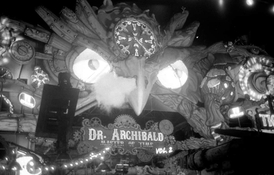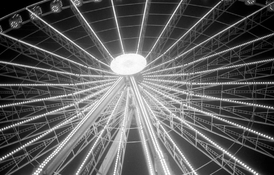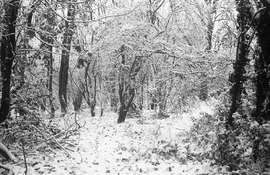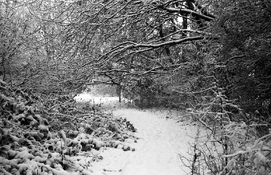You are using an out of date browser. It may not display this or other websites correctly.
You should upgrade or use an alternative browser.
You should upgrade or use an alternative browser.
Exeter Pan XX - what is it?
-
A
- Thread starter Agulliver
- Start date
Recent Classifieds
-
Want to Buy Wanted- Hasselblad 50mm c
- Started by eli griggs
-
Want to Buy Fuji GX680 III Kit
- Started by Christopherjs
-
Want to Buy Mamiya 645 Pro Kit w Sekor 80mm 1.9
- Started by Christopherjs
-
Want to Buy Leedal II 16x20 Tray Ladder
- Started by Grayjohn900
-
For Sale Linhof Kardan Color 45S large format camera
- Started by J Durr
Forum statistics
Agulliver
Member
I've shot another roll, this time 20 exposures which I attempted to push to 1600. A bit difficult when the seller suggests it can be processed as per fomapan 400 or Ilford HP5+ as both have different development times.
However, I split the difference, developing for 13 minutes in Microphen at about 20C with the usual inversions. The results are *very* pleasing for portraits. The portrait here was shot in a pub in late November with quite low light. I think the skin tones are rendered beautifully, do bear in mind the subject is of Mexican descent so definitely not pale skinned. The rest were from Hyde Park Winter Wonderland and suggest a lack of an effective anti-halation layer to my eyes. Still the results are OK.
I've read elsewhere that this may be Ilford surveillance film - traffic camera film. I did ask the vendor and they said they weren't permitted to say what it is. Developer didn't change colour so no coloured anti-halation dyes in there.
It is a curious film. Comes in cheaper than Ilford HP5+ when bought in bulk but probably no price break over Fomapan 400. I don't know that I'll buy more but I really do like how it renders portraits.
However, I split the difference, developing for 13 minutes in Microphen at about 20C with the usual inversions. The results are *very* pleasing for portraits. The portrait here was shot in a pub in late November with quite low light. I think the skin tones are rendered beautifully, do bear in mind the subject is of Mexican descent so definitely not pale skinned. The rest were from Hyde Park Winter Wonderland and suggest a lack of an effective anti-halation layer to my eyes. Still the results are OK.
I've read elsewhere that this may be Ilford surveillance film - traffic camera film. I did ask the vendor and they said they weren't permitted to say what it is. Developer didn't change colour so no coloured anti-halation dyes in there.
It is a curious film. Comes in cheaper than Ilford HP5+ when bought in bulk but probably no price break over Fomapan 400. I don't know that I'll buy more but I really do like how it renders portraits.
Attachments
Donald Qualls
Subscriber
Then again, Fomapan 400 is up against its limits at a two stop push -- while HP5+ has another stop or two left in it at that point. And that definitely looks better than Fomapan 400 pushed to 1600.
Agulliver
Member
Yeah Fomapan 400 pushed to 1600 really looks grainy and high contrast. This doesn't look like Fomapan at all. I am curious about the claim that it's Ilford speed camera film, but that isn't backed up by any evidence....just something I read online.
Agulliver
Member
Shot another roll in the snow today, at 400 and developed as per Ilford HP5+ in Microphen at 20C. Which produced pretty much perfect negatives. I'm in no position to draw any conclusions but I tentatively would say there could be something in the notion that this is Ilford speed camera film. I am prepared to say it's not Fomapan of any flavour. And I do think the development times for HP5+ work better than those for Fomapan 400.
I do actually like this film.
Shots all taken with a Yashica Minister III.
I do actually like this film.
Shots all taken with a Yashica Minister III.
Attachments
Last edited:
Tel
Subscriber
Some very nice shots there. I say, whatever it is if you like it and the price is right...stock up!
Agulliver
Member
Some very nice shots there. I say, whatever it is if you like it and the price is right...stock up!
It's clearly not Fomapan of any flavour. I've shot enough Foma to know that only Fomapan 400 could possibly be pushed to 800 or 1600 as my second roll if this stuff was, and when I do that it's very contrasty and grainy. So whatever it is, the price probably isn't bad. It's definitely not Agfa Aviphot 200 either because I've shot that as Rollei branded film and (probably) CatLabs branded film. The person elsewhere who suspects it's Ilford P4 surveillance film could be right. I've seen some shots using that film on the Lomography site and there are similarities.
So...anyone interested in this Exeter Pan stuff....it does look nice and it *may* be Ilford P4 surveillance film.
@Agulliver and others
I think I know what the film stock is. As your photos with 1600 pushed show, it seems to have a strong halation effect. There is a film from Kodak known as Kodak Plus X, and it has two variants: one for regular use and one for science or aerographic uses. The plus-X aerographic film is rated at 200, and it has very thin anti-halation (maybe the same as Remjet) on it, while the film for military and science uses doesn't have anti-halation on it. The Aerographic film is 70 mm, and the other is 35 mm. We also had the film for regular use, but I think it has edge marks. So I believe this is the military/science film known as Kodak Plus X. And also, the name on the bulk tin says it is "Pan XX" film because the Plus X has a basically similar base and silver coating as the Double XX film, and the film is near-infrared, which is helpful for reconnaissance purposes. From the colour of the film and its thin base with dense negative images on it, I can be sure 99% that it is Kodak Plus X, and I assume that the seller may have a long bulk of the 35mm type or he may have a film splitter with one middle hole punch to split the 70mm (or the 5” roll) film into 35mm with sprocket holes on both sides. However, it will be a difficult job to do, and they also have to remove the anti-halation layer to make it more light sensitive and rate it as EI400 (sound similar to Cinestill 800T), but that layer is easy to remove as you just need to use water to wash the anti-halation coating off (not stubbon like Cine film), but they have to dry the film after all and then respool it back onto a cassette.
Please find the data sheet from the link below.
I think I know what the film stock is. As your photos with 1600 pushed show, it seems to have a strong halation effect. There is a film from Kodak known as Kodak Plus X, and it has two variants: one for regular use and one for science or aerographic uses. The plus-X aerographic film is rated at 200, and it has very thin anti-halation (maybe the same as Remjet) on it, while the film for military and science uses doesn't have anti-halation on it. The Aerographic film is 70 mm, and the other is 35 mm. We also had the film for regular use, but I think it has edge marks. So I believe this is the military/science film known as Kodak Plus X. And also, the name on the bulk tin says it is "Pan XX" film because the Plus X has a basically similar base and silver coating as the Double XX film, and the film is near-infrared, which is helpful for reconnaissance purposes. From the colour of the film and its thin base with dense negative images on it, I can be sure 99% that it is Kodak Plus X, and I assume that the seller may have a long bulk of the 35mm type or he may have a film splitter with one middle hole punch to split the 70mm (or the 5” roll) film into 35mm with sprocket holes on both sides. However, it will be a difficult job to do, and they also have to remove the anti-halation layer to make it more light sensitive and rate it as EI400 (sound similar to Cinestill 800T), but that layer is easy to remove as you just need to use water to wash the anti-halation coating off (not stubbon like Cine film), but they have to dry the film after all and then respool it back onto a cassette.
Please find the data sheet from the link below.
Tom Poynton
Member
@Agulliver and others
I think I know what the film stock is. As your photos with 1600 pushed show, it seems to have a strong halation effect. There is a film from Kodak known as Kodak Plus X, and it has two variants: one for regular use and one for science or aerographic uses. The plus-X aerographic film is rated at 200, and it has very thin anti-halation (maybe the same as Remjet) on it, while the film for military and science uses doesn't have anti-halation on it. The Aerographic film is 70 mm, and the other is 35 mm. We also had the film for regular use, but I think it has edge marks. So I believe this is the military/science film known as Kodak Plus X. And also, the name on the bulk tin says it is "Pan XX" film because the Plus X has a basically similar base and silver coating as the Double XX film, and the film is near-infrared, which is helpful for reconnaissance purposes. From the colour of the film and its thin base with dense negative images on it, I can be sure 99% that it is Kodak Plus X, and I assume that the seller may have a long bulk of the 35mm type or he may have a film splitter with one middle hole punch to split the 70mm (or the 5” roll) film into 35mm with sprocket holes on both sides. However, it will be a difficult job to do, and they also have to remove the anti-halation layer to make it more light sensitive and rate it as EI400 (sound similar to Cinestill 800T), but that layer is easy to remove as you just need to use water to wash the anti-halation coating off (not stubbon like Cine film), but they have to dry the film after all and then respool it back onto a cassette.
Please find the data sheet from the link below.
I notice they also sell something called ”Exeter Pan X“ which they state as being “similar to Plus X” https://www.ebay.co.uk/itm/334381380231
pentaxuser
Member
Did you ask him who hadn't given him permission to say what it is and if so what did he then say?I've read elsewhere that this may be Ilford surveillance film - traffic camera film. I did ask the vendor and they said they weren't permitted to say what it is.
Thanks
pentaxuser
Agulliver
Member
@pentaxuser I believe he meant that the manufacturer doesn't want him revealing the origin of the film.
I've still got three cassettes of 18 exposures each that I rolled from the length I bought. Probably use them at 400 in the spring.
I've still got three cassettes of 18 exposures each that I rolled from the length I bought. Probably use them at 400 in the spring.
pentaxuser
Member
OK Did he actually say this or was that your conclusion from the context of what he said?@pentaxuser I believe he meant that the manufacturer doesn't want him revealing the origin of the film.
Presumably he buys enough of this film from the manufacturer to alert it to the fact that he sells it in a quantity sufficient that it feels some kind of commercial harm to it will follow unless he maintains secrecy? Does that mean that it is current film that the manufacturer cannot sell enough and so has to release the surplus to "other sellers" but in case the price charged by the seller undercuts its own film it cannot afford to have him reveal what it is?
Does it sell to other e-bay sellers and apply the same restriction to them but there it is called St Albans, Barnstaple or wherever the the other seller lives or some other name that is invented by the seller?
Just speculation on my part as to the reasons but it all seems rather strange
pentaxuser
Arvee
Member
Here is what the actual film looks like. Not many clues, except it doesn't have the motion picture perforations.
I just finished a 100' roll of UltraFine Finesse 400; the color of the emulsion and the perforation shape in your photos is identical to my last rolls I spooled yesterday. I was not able to discover the origin of Finesse but I'm positive that it's from the same stock as yours. I purchased several rolls of Kentmere 400 thinking Finesse might be K400 but there were no similarities whatsoever.
Arvee
Member
@Agulliver and others
I think I know what the film stock is. As your photos with 1600 pushed show, it seems to have a strong halation effect. There is a film from Kodak known as Kodak Plus X, and it has two variants: one for regular use and one for science or aerographic uses. The plus-X aerographic film is rated at 200, and it has very thin anti-halation (maybe the same as Remjet) on it, while the film for military and science uses doesn't have anti-halation on it. The Aerographic film is 70 mm, and the other is 35 mm. We also had the film for regular use, but I think it has edge marks. So I believe this is the military/science film known as Kodak Plus X. And also, the name on the bulk tin says it is "Pan XX" film because the Plus X has a basically similar base and silver coating as the Double XX film, and the film is near-infrared, which is helpful for reconnaissance purposes. From the colour of the film and its thin base with dense negative images on it, I can be sure 99% that it is Kodak Plus X, and I assume that the seller may have a long bulk of the 35mm type or he may have a film splitter with one middle hole punch to split the 70mm (or the 5” roll) film into 35mm with sprocket holes on both sides. However, it will be a difficult job to do, and they also have to remove the anti-halation layer to make it more light sensitive and rate it as EI400 (sound similar to Cinestill 800T), but that layer is easy to remove as you just need to use water to wash the anti-halation coating off (not stubbon like Cine film), but they have to dry the film after all and then respool it back onto a cassette.
Please find the data sheet from the link below.
40
I think you may be correct in identifying this mystery film. It does indeed have a very thin anti halation layer; it is definitely not opaque and one can see through the film when held up against the light. Also, it has much finer grain that I expected for a 400 speed film which would match your speed rating of 200 for the scientific version of Plus-X and looks very much like the Plus-X I used years ago. I've been developing in Rodinal and have been getting very sharp, virtually grainless negs.
Last edited:
Agulliver
Member
I've shot another roll at 1600, I thought I'd evaluate it's pushing potential again under somewhat unusual lighting....the stage lights are mostly purple and green in real life.
This is definitely not what this film was intended for, but it's doing a decent job. I'm curious about the possible Kodak stock this might be. Mulling over buying some more. I definitely prefer it to Fomapan 400 in most circumstances.
This is definitely not what this film was intended for, but it's doing a decent job. I'm curious about the possible Kodak stock this might be. Mulling over buying some more. I definitely prefer it to Fomapan 400 in most circumstances.
Attachments
they also have to remove the anti-halation layer to make it more light sensitive and rate it as EI400 (sound similar to Cinestill 800T)
I know this is already a few months old, but still. Removing an antihalation dye or layer from film doesn't make it faster. It just promotes halation. That's not the same as an overall speed gain although very locally, around bright highlights, it can sort of look somewhat similar, I suppose (I'm granting the argument a lot of slack in putting it like this!) It's as much a "speed gain" as using an uncoated lens is - and that's in similar ways stretching the concept of a speed gain beyond what I find reasonable.
The reason why Cinestill is typically rated 2/3 stops over the box speed of the original film is because Cinestill market their actual ECN2 films for C41 development, and this boosts the gamma (contrast) if the image. If you C41 process ECN2 film, you get basically a push-processed color negative (with somewhat twisted color balance). To make C41 possible without creating massive problems for existing C41 labs, it's necessary to remove the remjet from these films. If it's not removed, the apparent speed gain is still there. It's unrelated to the remjet backing, and it's also not a real speed gain.
I imagine it's also more attractive to market an 800 film instead of a 500 one; more speed is more better, after all...
Agulliver
Member
I've used Vision 3 500T with the remjet removed, branded as "Candido".
I've used it as Cinestill in 120 format and found it performed approximately at its real box speed of 500 when shot under tungsten-balanced light and processed in ECN2 developer. I don't doubt you'll get perfectly scannable (scanners are just great in extracting shadow detail!) and perhaps even printable negatives when processed in C41 and exposed at EI800. Personally I stick to true box speed for these films and push process in ECN2 developer, which gives me very acceptable negatives with good shadow detail and a color balance that sort of prints OK on RA4.
pentaxuser
Member
I imagine it's also more attractive to market an 800 film instead of a 500 one; more speed is more better, after all...
A marketing edge? That surely can't be the real reason, can it?

pentaxuser
Agulliver
Member
The negs I got from the Candido film looked better in terms of density than Portra 800 shot in the same camera, in the same conditions. So I am in no doubt that the speed is close enough to 800 as makes no difference. That roll was shot in a jazz club. My latest is a mixture of outside on a cloudy day and a gig with purple/green stage lighting so that'll be interesting.
Removing an antihalation dye or layer from film doesn't make it faster. It just promotes halation.
I'm going to differ with you on this - at least a little bit.
It would be mostly true for 120 film, because of the backing paper. But for 35mm film, or sheet film for that matter, the removal of anti-halation is likely to result in a need to change how you meter the film, because the the increased halation will result in additional fogging exposure to the light sensitive components in the emulsion, which will tend to boost negative density, particularly in the shadows.
It is much like the results from using uncoated lenses - it has the most effect in the shadow areas which are near the film's threshold for low level exposure.
pentaxuser
Member
But for 35mm film, or sheet film for that matter, the removal of anti-halation is likely to result in a need to change how you meter the film, because the the increased halation will result in additional fogging exposure to the light sensitive components in the emulsion, which will tend to boost negative density, particularly in the shadows.
It is much like the results from using uncoated lenses - it has the most effect in the shadow areas which are near the film's threshold for low level exposure.
Interesting. How much of a difference to the metering will this make, Matt? Presumably enough to cause an alteration of the film speed dial so for example a 400 film without anti-halation or less anti-halation as is claimed to be the case for Kentmere 400 compared to say Ilford HP5+ 400 might be better rated at 320?
Thanks
pentaxuser
But for 35mm film, or sheet film for that matter, the removal of anti-halation is likely to result in a need to change how you meter the film, because the the increased halation will result in additional fogging exposure to the light sensitive components in the emulsion, which will tend to boost negative density, particularly in the shadows.
Only locally, near bright highlights. That's what halation is: light bleeding across a larger spot around a highlight. That's a different mechanism than speed increase, and it does not warrant a different approach in metering. At best, it requires things like acceptance of the effect, taking it into account or even exploiting it in composition, etc. You're free to feel the way you do, of course, but as a line of reasoning why removing anti-halation dyes from film would increase speed, I'm not buying it.
it has the most effect in the shadow areas
But other than uncoated lenses, there's a very clear and limited spatial relationship between highlights and shadows where the supposed speed increase (quod non) occurs.
Agulliver
Member
Looking back over this thread, I'm still puzzled as to what Exeter-Pan film is. It says "Made in EU" which gives us very few possibilities. Kodak XX has come up recently as a possibility or the scientific Kodak Plus-X....but is either made in the EU? EU could mean Harman prior to Brexit or Foma, Agfa, possibly Inoviscoat or OrWo?
Whatever the stuff is, I've decided that I like it and can live with the halation effects. Can't currently buy any more as the seller is on holiday until 7 August but I'll check back after that.
Whatever the stuff is, I've decided that I like it and can live with the halation effects. Can't currently buy any more as the seller is on holiday until 7 August but I'll check back after that.
Donald Qualls
Subscriber
Maybe pre-Brexit Kentmere?
| Photrio.com contains affiliate links to products. We may receive a commission for purchases made through these links. To read our full affiliate disclosure statement please click Here. |
PHOTRIO PARTNERS EQUALLY FUNDING OUR COMMUNITY:  |















